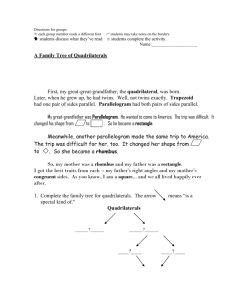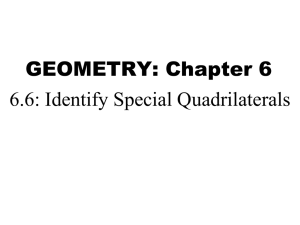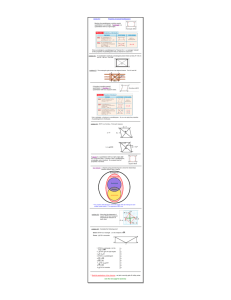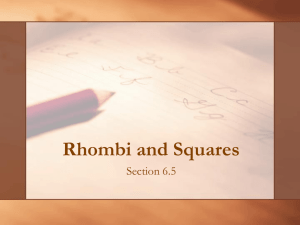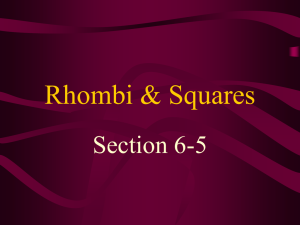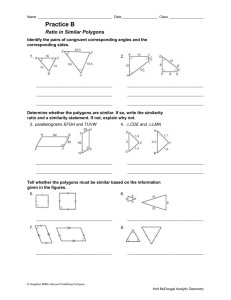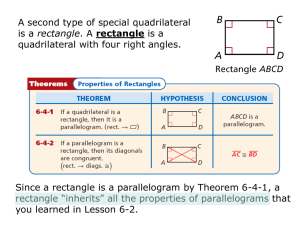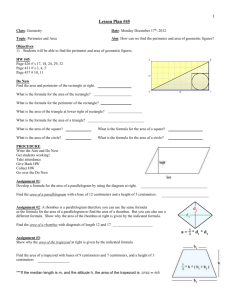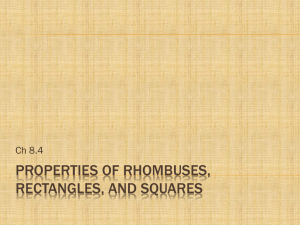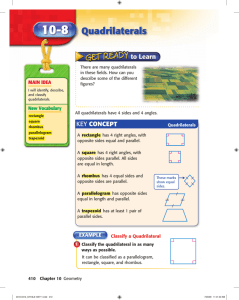over Lesson 10-6 - Mr. Nelson`s Math
advertisement
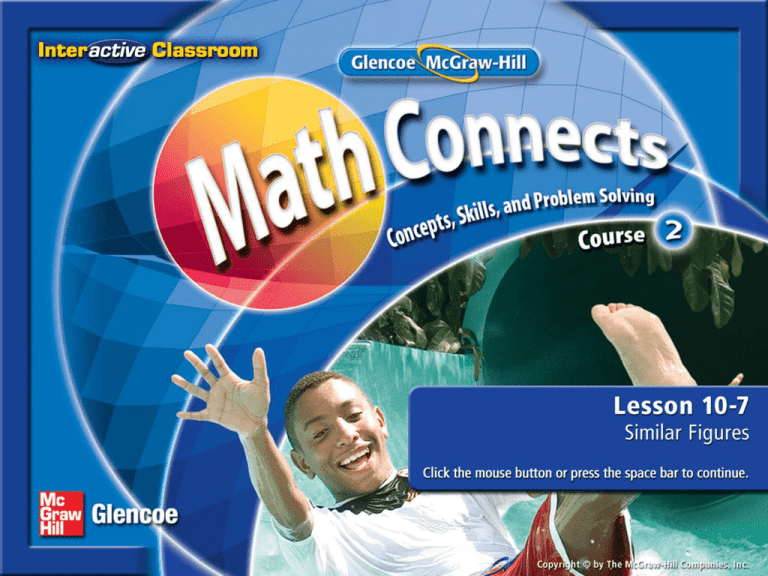
Five-Minute Check (over Lesson 10–6) Main Idea and Vocabulary Key Concept: Similar Figures Example 1: Identify Similar Figures Example 2: Find Side Measures of Similar Triangles Example 3: Real-World Example • Determine whether figures are similar and find a missing length in a pair of similar figures. • Corresponding Angles: The angles of similar figures that “match”. • Corresponding Sides: The sides of similar figures that “match”. • Indirect Measurement: Uses similar figures to find the length, width, or height of objects that are too difficult to measure directly. • Similar Figures: Figures that have the same shape but not necessarily the same size. Identify Similar Figures Which rectangle is similar to rectangle FGHI? Identify Similar Figures Find the ratios of the corresponding sides to see if they form a constant ratio. Answer: So, rectangle ABCD is similar to rectangle FGHI. Which rectangle is similar to rectangle WXYZ? A. C. B. 1. 2. 3. A B C Find Side Measures of Similar Triangles If ΔABC ~ ΔDEF, find the length of . Find Side Measures of Similar Triangles Since the two triangles are similar, the ratios of their corresponding sides are equal. So, you can write and solve a proportion to find . Answer: If ΔJKL ~ ΔMNO, find the length of . A. 9 in. B. 11.5 in. C. 13.5 in. D. 15 in. 1. 2. 3. 4. A B C D ARCHITECTURE A rectangular picture window 12 feet long and 6 feet wide needs to be shortened to 9 feet in length to fit a redesigned wall. If the architect wants the new window to be similar to the old window, how wide will the new window be? Answer: So, the width of the new window will be 4.5 feet. Tom has a rectangular garden which has a length of 12 feet and a width of 8 feet. He wishes to start a second garden which is similar to the first and will have a width of 6 feet. Find the length of the new garden. A. 4 ft B. 6 ft C. 9 ft D. 10 ft 1. 2. 3. 4. A B C D End of the Lesson Five-Minute Check (over Lesson 10–6) Image Bank Math Tools Tessellations Translations (over Lesson 10-6) Classify the quadrilateral using the name that best describes it. Determine and explain whether the statement is sometimes, always, or never true. A square is a parallelogram. Determine and explain whether the statement is 1. A B sometimes, always, or never true. A rhombus is a2. square. 3. 4. Which of the following is not a parallelogram? A. Sqaure B. rectangle C. Trapezoid D. rhombus C D (over Lesson 10-6) Classify the quadrilateral using the name that best describes it. A. square B. rectangle C. rhombus D. trapezoid 1. 2. 3. 4. A B C D (over Lesson 10-6) Classify the quadrilateral using the name that best describes it. A. square B. rectangle C. rhombus D. trapezoid 1. 2. 3. 4. A B C D (over Lesson 10-6) Determine and explain whether the statement is sometimes, always, or never true. A square is a parallelogram. A. B. C. Sometimes; parallelograms are quadrilaterals with opposite sides parallel and all sides are not always congruent. Always; parallelograms are quadrilaterals with opposite sides parallel and opposite sides congruent. Never; parallelograms are quadrilaterals with only opposite angles congruent. All sides are not congruent. 1. 2. 3. A B C (over Lesson 10-6) Determine and explain whether the statement is sometimes, always, or never true. A rhombus is a square. A. B. C. Sometimes true; a rhombus is a parallelogram with 4 congruent sides. If a rhombus also has 4 right angles, it is a square. Always true; all four sides and angles of a rhombus are equal. Never true; an angle of a rhombus cannot be 90° whereas an angle of a square is always 90°. 1. 2. 3. A B C (over Lesson 10-6) Which of the following is not a parallelogram? A. sqaure B. rectangle C. trapezoid D. rhombus 1. 2. 3. 4. A B C D
